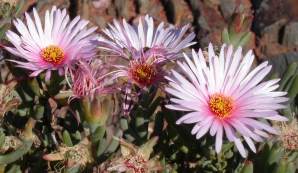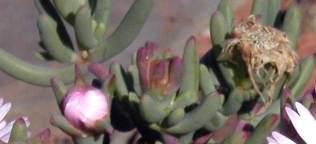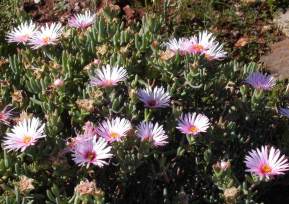Lampranthus haworthii
Lampranthus haworthii (Donn) N.E.Br.
Family: Aizoaceae
Common names: purple vygie, ice plant, mesemb
Introduction
This is a tall, robust plant by vygie standards, with large, metallic pink, white or light purple flowers.

Description
Description
Lampranthus haworthii is a tall, compact, erect subshrub that can grow as tall as 700 mm and as wide as 1 m. The leaves are fused at the base and are 40 x 6 mm, cylindrical in shape and bluish-green in colour. The flowers are 70 mm in diameter and are borne on a pedicel (stem), 20 to 40 mm long. Flower colour ranges from white, pale pink to light mauve. Flowering time is from mid-July to mid-September.

Distribution and habitat
Distribution description
Lampranthus haworthii occurs in the Little Karoo and Worcester/Robertson Karoo and is fairly common in and around the Worcester area. They are primarily winter rainfall plants. The genus Lampranthus occurs mainly in the Western Cape, Northern Cape and southern Namibia, although some species do occur in Eastern Cape as well. 
Derivation of name and historical aspects
History
The name is derived from the Greek words lampros (bright) and anthos (flower), referring to the large, showy flowers. Lampranthus is one of the largest genera in the Aizoaceae family. The genus consists of 227 species and 13 varieties. The species haworthii is named after a British succulent expert, Adrian Haworth (1768-1853).
Ecology
Ecology
Plants are pollinated by insects at midday when flowers are fully open. Mainly bees do this job. The flowers open at 10 a.m. and close at 3 p.m. Swollen leaves full of water ensure the survival of the plant during long hot and dry spells, especially the summers in the winter rainfall areas. Brightly coloured flowers are like beacons to pollinators, ensuring good seed production.
Another adaptation for survival for mesembs is the abundance of seeds that are produced. Seeds are released by means of winged valves that open when wet. There are layers of membranes in these valves that ensure all the seeds are not released at one time. If this was the case and no follow-up rains fell, the seedlings would all die, which could compromise the very survival of a rare species. The more seeds there are, the better the chances of germination and ultimately the survival of the species.
Uses
Use
There are no medicinal or traditional uses associated with these plants. They are, however, sought out for their use in the garden. Lampranthus haworthii is popular in the horticultural industry. The plants are very showy and tough, and make fantastic water-wise subjects.
Growing Lampranthus haworthii
Grow
To achieve optimum results, strike cuttings either in spring or autumn. Cuttings 100 -120 mm in length should be used, preferably tip cuttings with relatively new growth. Avoid old, woody or diseased material.
Plants can also be grown from seed. The best time for sowing seed is in spring or autumn, avoiding the cold of winter and the extreme heat of summer unless you have a controlled environment. Use flat, plastic seed pans for sowing. Under ideal conditions, fresh, viable seed will germinate within 3 - 5 days.
Sow seed in well-drained, loamy soil. The top layer can be sieved, coarse river sand. If you do cover the seed, cover 1 mm and no deeper! Water with a fine spray. Do not use water under force or a jet of water as this is likely to blast the seed out of its container.
A suggested garden layout is to combine this particular species with other related species in mixed or single colour groups. Other bright-coloured species are Lampranthus multiradiatus, L. aureus and L. reptans. L. glaucoides can also be used in rock gardens, on steep slopes or embankments as mass plantings. L. affinis is a good choice for shady spots. Remember that L. haworthii plants are tall, so plant at the back of your garden layout.
Not many pests attack these plants, although occasionally they suffer from soft brown scale or mealie bug. Use a systemic pesticide or oleum mineral oil.
Feeding tips: use compost, bone meal or a seaweed-based organic fertiliser, which will enhance healthy growth of plants.
References
- Jacobsen, H. 1974. Lexicon of succulent plants. Blandford Press, London.
- Smith, G.F. et al. 1998. Mesembs of the world. Briza Publications, Pretoria.
Credits
Ian Oliver
Karoo Desert NBG
August 2003
Plant Attributes:
Plant Type: Succulent
SA Distribution: Western Cape
Soil type: Sandy, Loam
Flowering season: Spring, Winter
PH:
Flower colour: White, Pink, Mauve/Lilac
Aspect: Full Sun
Gardening skill: Average
Special Features:
Horticultural zones








Rate this article
Article well written and informative
Rate this plant
Is this an interesting plant?
Login to add your Comment
Back to topNot registered yet? Click here to register.